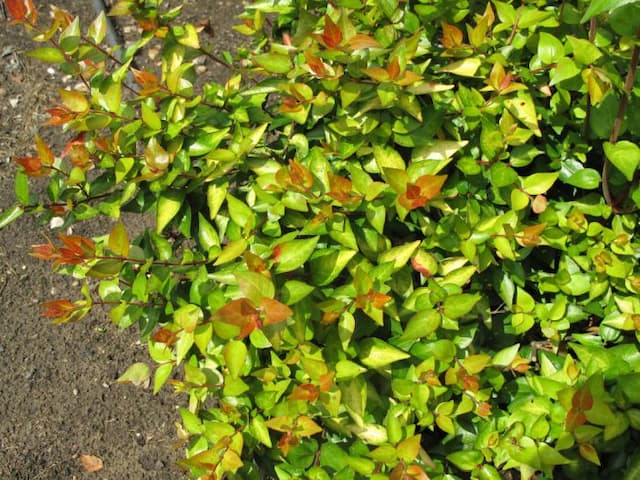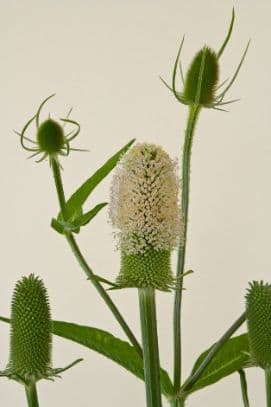Pincushion Flower Scabiosa farinosa

ABOUT
Scabiosa farinosa, more commonly known as the Pincushion Flower, is a charming perennial that features a unique floral display. The plant is graced with blooms that are typically soft lavender to blue in color, although some varieties may present flowers in hues of pink, white, or deep purples. Each flower is spherical, resembling a pincushion dotted with tiny pins – these 'pins' are actually the protruding styles of the flowers, enhancing the intricate texture of the bloom. The flowers are borne on slender stems that rise elegantly above the foliage. The leaves of the Pincushion Flower add to its ornamental appeal. They are generally basal, which means they grow at the base of the stem, forming a low mound of foliage that stays closer to the ground. The leaves are oblong to lanceolate in shape with a somewhat wrinkled or ruffled texture and a grayish-green color that can sometimes appear powdery or frosted, adding to the common name referencing flour (farinosa). The contrasting colors and textures between the foliage and the blossoms create an attractive display in garden settings. Overall, the Pincushion Flower exudes a delicate charm that makes it a favorite among gardeners aiming for a cottage garden look or desiring plants that provide a soft, airy feel to the landscape. Despite the absence of specific size dimensions, it is a plant that is valued for its distinctive flowers and attractive foliage, fitting nicely in borders, rock gardens, or as part of a wildflower collection.
About this plant
 Names
NamesFamily
Caprifoliaceae
Synonyms
Pincushion Flower, Scabious, Mourning Bride
Common names
Scabiosa farinosa
 Toxicity
ToxicityTo humans
Scabiosa farinosa, commonly known as Pincushion Flower, is not widely recognized as a toxic plant to humans. There is limited information on its toxicity, and it is generally considered not harmful. However, as with many plants, individual allergies or sensitivities may exist, and it is advisable to handle plants with care and to avoid ingesting any parts of plants that are not known to be edible. If an individual does ingest part of the Pincushion Flower and experiences adverse symptoms, it is important to seek medical advice.
To pets
Scabiosa farinosa, known as Pincushion Flower, is not typically listed as a toxic plant for pets. There is a lack of reports regarding its toxicity to pets such as dogs and cats. Nonetheless, it is always prudent to discourage pets from consuming non-food plants as individual animals may have sensitivities or allergic reactions. If a pet ingests this plant and shows signs of distress or illness, it is recommended to consult a veterinarian.
 Characteristics
CharacteristicsLife cycle
Perennials
Foliage type
Deciduous
Color of leaves
Green
Flower color
Varies
Height
1-2 feet (30-60 cm)
Spread
1-2 feet (30-60 cm)
Plant type
Herb
Hardiness zones
Varies
Native area
Europe
Benefits
 General Benefits
General Benefits- Attracts Pollinators: Scabiosa farinosa is known for attracting bees, butterflies, and other beneficial pollinators to the garden, enhancing pollination of surrounding plants.
- Aesthetic Appeal: With its delicate flowers and attractive form, this plant adds beauty and visual interest to garden beds, borders, and containers.
- Drought Tolerance: Once established, Scabiosa farinosa is quite drought-resistant, making it suitable for xeriscaping and low-water gardens.
- Wildlife Habitat: The plant provides nectar and habitat for various insects, contributing to the biodiversity of the environment.
- Easy to Grow: It is generally easy to care for and cultivate, requiring minimal maintenance once settled in the right conditions.
- Long Blooming Period: The pincushion flower, another name for it, has a lengthy blooming season, providing color and interest for an extended period.
- Soil Improvement: Scabiosa farinosa can help in improving soil structure and health with its root system.
 Medical Properties
Medical PropertiesThis plant is not used for medical purposes.
 Air-purifying Qualities
Air-purifying QualitiesThis plant is not specifically known for air purifying qualities.
 Other Uses
Other Uses- Scabiosa farinosa, commonly known as the pincushion flower, can be used as a natural dye, providing a range of colors from yellow to green depending on the mordant used.
- The flowers of the pincushion flower can be used as a source of nectar for honey production, adding a unique flavor to the honey.
- Dried pincushion flowers are often used in potpourri mixtures for their long-lasting fragrance and attractive appearance.
- These flowers can be crushed to create a natural insect repellent, although their effectiveness might be less than commercial products.
- The seed heads of Scabiosa farinosa are sometimes used in traditional crafts, especially in dried flower arrangements and wreaths.
- Throughout history, the plant has been used in folk art to symbolize warmth and attraction in pressed flower crafts.
- Gardeners may use the pincushion flower as a companion plant to deter certain pests from more susceptible plants in the garden.
- The fibrous stems of the plant have been occasionally used in paper-making workshops for creating handmade paper with a unique texture.
- Pincushion flowers can be incorporated into educational activities for children as they have distinct shapes that can be used to teach about plant biology and life cycles.
- The plant's ability to attract beneficial pollinators like bees and butterflies makes it ideal for ecological gardening and biodiversity conservation projects.
Interesting Facts
 Feng Shui
Feng ShuiThe Pincushion Flower is not used in Feng Shui practice.
 Zodiac Sign Compitability
Zodiac Sign CompitabilityThe Pincushion Flower is not used in astrology practice.
 Plant Symbolism
Plant Symbolism- Love and Admiration: Scabiosa, also commonly known as Pincushion Flower, often symbolizes love and admiration, making it a popular choice for romantic occasions.
- Purity and Innocence: The delicate appearance of the Pincushion Flower gives it a connotation of purity and innocence, similar to other light-colored blooms.
- Beauty: Scabiosa flowers are appreciated for their unique, textured blooms and are often associated with unconventional beauty.
- Widow Flower: In some cultures, Scabiosa is known as the widow flower and can represent loss or mourning, as it was often seen in graveside arrangements.
 Water
WaterFor Pincushion flowers, which is the common name for Scabiosa farinosa, it is essential to maintain evenly moist soil, particularly during the growing season. Water them thoroughly when the top inch of soil feels dry to the touch, which typically means about once a week. Using a watering can or a soft stream from a garden hose, apply water directly to the base of the plant to avoid wetting the foliage, as this can lead to fungal diseases. Depending on the size of the plant and the climate, you might need about one gallon of water per plant every week during peak summer months.
 Light
LightPincushion flowers thrive best in full sun conditions, where they can receive at least six to eight hours of direct sunlight per day. Plant them in a spot that is exposed to morning sunlight and with some afternoon shade in extremely hot climates. Avoid locations where buildings, trees, or other structures might cast too much shade over the flowers, as too little light can inhibit their blooming and lead to leggy growth.
 Temperature
TemperaturePincushion flowers prefer temperate climates with temperatures ranging between 60°F and 75°F for optimal growth. They can tolerate a minimum temperature of just above freezing at 34°F and a maximum temperature of around 85°F. In regions with very hot summers or very cold winters, extra care such as mulching or providing shelter may be required to protect the flowers from extreme temperatures.
 Pruning
PruningPruning Pincushion flowers involves deadheading spent blooms to encourage continued flowering throughout the season. Cut back the stems to just above a set of leaves. Light pruning can be done throughout the blooming period to maintain shape and promote vigorous growth, while more extensive cutting back can take place in early spring or after the first frost in autumn to prepare the plant for the next growing season.
 Cleaning
CleaningAs needed
 Soil
SoilThe Pincushion Flower prefers well-draining soil with a mix of sand, loam, and compost to ensure good drainage and fertility. Aim for a soil pH between 6.0 to 7.5 for optimal growth.
 Repotting
RepottingPincushion Flowers do not need frequent repotting and can thrive in the same pot for a few years. However, repot if you notice roots circling the pot or if growth seems stunted.
 Humidity & Misting
Humidity & MistingPincushion Flowers enjoy moderate humidity levels but are also quite adaptable. Average room humidity is generally sufficient for healthy growth.
 Suitable locations
Suitable locationsIndoor
Place in bright, indirect light with some direct sun, and ensure good air circulation.
Outdoor
Full sun to partial shade, shelter from strong winds, and well-draining soil.
Hardiness zone
3-9 USDA
 Life cycle
Life cycleScabiosa farinosa, commonly known as the Scabious flower, begins its life as a seed that germinates in the spring when soil temperatures rise and moisture is adequate. Upon sprouting, the seedling establishes a small rosette of leaves at soil level, from which it grows a deep taproot and begins vegetative growth. As the plant matures, it develops a flowering stem with characteristic pincushion-like flower heads, typically blooming in the summer months. Following pollination by insects attracted to its nectar and pollen, Scabiosa farinosa sets fruit, producing small, dry seeds that are distributed by wind, facilitating the spread of the species. The plant may die after setting seed if it is an annual variety, or it may enter a period of dormancy in colder months if it is a perennial, to re-emerge the following season. Throughout its lifecycle, the Scabious flower requires well-drained soil and plenty of sunlight to thrive.
 Propogation
PropogationPropogation time
Spring-Early Summer
Scabiosa farinosa, commonly known as pincushion flower, is typically propagated by seed. The ideal time to sow pincushion flower seeds is in spring after the danger of frost has passed. To propagate, seeds are sown directly into well-drained soil in a sunny location, lightly covered with soil, and kept moist until germination occurs. Germination generally takes 2 to 3 weeks at a soil temperature of about 70 degrees Fahrenheit (approximately 21 degrees Celsius). Once seedlings have developed and are large enough to handle, they can be thinned or transplanted to their final growing positions, ensuring they are spaced adequately to allow for mature growth. It's important to note that pincushion flowers prefer a sunny spot with soil that drains well and do not tolerate wet feet.








